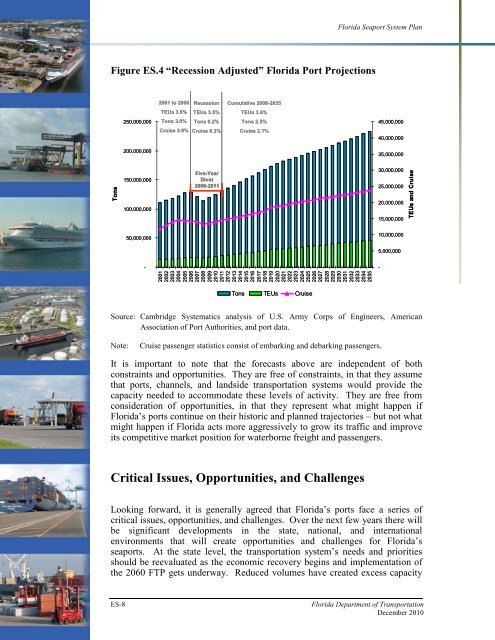Florida Seaport System Plan - SeaCIP
Florida Seaport System Plan - SeaCIP
Florida Seaport System Plan - SeaCIP
You also want an ePaper? Increase the reach of your titles
YUMPU automatically turns print PDFs into web optimized ePapers that Google loves.
<strong>Florida</strong> <strong>Seaport</strong> <strong>System</strong> <strong>Plan</strong><br />
Figure ES.4 “Recession Adjusted” <strong>Florida</strong> Port Projections<br />
2001 to 2006<br />
Recession<br />
Cumulative 2008-2035<br />
TEUs 3.6%<br />
TEUs 3.5%<br />
TEUs 3.6%<br />
250,000,000<br />
Tons 3.0%<br />
Tons 0.2%<br />
Tons 2.5%<br />
45,000,000<br />
Cruise 3.9%<br />
Cruise 0.3%<br />
Cruise 2.1%<br />
40,000,000<br />
200,000,000<br />
35,000,000<br />
150,000,000<br />
100,000,000<br />
50,000,000<br />
-<br />
2001<br />
2002<br />
2003<br />
2004<br />
2005<br />
2006<br />
2007<br />
2008<br />
2009<br />
2010<br />
2011<br />
2012<br />
2013<br />
2014<br />
2015<br />
2016<br />
2017<br />
2018<br />
2019<br />
2020<br />
2021<br />
2022<br />
2023<br />
2024<br />
2025<br />
2026<br />
2027<br />
2028<br />
2029<br />
2030<br />
2031<br />
2032<br />
2033<br />
2034<br />
2035<br />
Tons<br />
Five-Year<br />
Divot<br />
2006-2011<br />
30,000,000<br />
25,000,000<br />
20,000,000<br />
15,000,000<br />
TEUs and Cruise<br />
10,000,000<br />
5,000,000<br />
-<br />
Tons TEUs Cruise<br />
Source: Cambridge <strong>System</strong>atics analysis of U.S. Army Corps of Engineers, American<br />
Association of Port Authorities, and port data.<br />
Note:<br />
Cruise passenger statistics consist of embarking and debarking passengers.<br />
It is important to note that the forecasts above are independent of both<br />
constraints and opportunities. They are free of constraints, in that they assume<br />
that ports, channels, and landside transportation systems would provide the<br />
capacity needed to accommodate these levels of activity. They are free from<br />
consideration of opportunities, in that they represent what might happen if<br />
<strong>Florida</strong>’s ports continue on their historic and planned trajectories – but not what<br />
might happen if <strong>Florida</strong> acts more aggressively to grow its traffic and improve<br />
its competitive market position for waterborne freight and passengers.<br />
Critical Issues, Opportunities, and Challenges<br />
Looking forward, it is generally agreed that <strong>Florida</strong>’s ports face a series of<br />
critical issues, opportunities, and challenges. Over the next few years there will<br />
be significant developments in the state, national, and international<br />
environments that will create opportunities and challenges for <strong>Florida</strong>’s<br />
seaports. At the state level, the transportation system’s needs and priorities<br />
should be reevaluated as the economic recovery begins and implementation of<br />
the 2060 FTP gets underway. Reduced volumes have created excess capacity<br />
ES-8<br />
<strong>Florida</strong> Department of Transportation<br />
December 2010
















